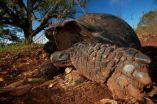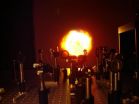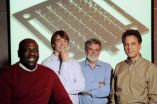(Press-News.org) Athens, Ga. – Researchers at the University of Georgia have discovered that a virus commonly found in dogs may serve as the foundation for the next great breakthrough in human vaccine development.
Although harmless in humans, parainfluenza virus 5, or PIV5, is thought to contribute to upper respiratory infections in dogs, and it is a common target for canine vaccines designed to prevent kennel cough. In a paper published recently in PLOS ONE, researchers describe how this virus could be used in humans to protect against diseases that have eluded vaccine efforts for decades.
"We can use this virus as a vector for all kinds of pathogens that are difficult to vaccinate against," said Biao He, the study's principal investigator and professor of infectious diseases in UGA's College of Veterinary Medicine. "We have developed a very strong H5N1 flu vaccine with this technique, but we are also working on vaccines for HIV, tuberculosis and malaria."
PIV5 does not cause disease in humans, as our immune system is able to recognize and destroy it. By placing antigens from other viruses or parasites inside PIV5, it effectively becomes a delivery vehicle that exposes the human immune system to important pathogens and allows it to create the antibodies that will protect against future infection.
This approach not only ensures full exposure to the vaccine but also is much safer because it does not require the use of attenuated, or weakened, pathogens. For example, an HIV vaccine delivered by PIV5 would contain only those parts of the HIV virus necessary to create immunity, making it impossible to contract the disease from the vaccine.
"Safety is always our number one concern," said He, who is also a Georgia Research Alliance distinguished investigator and member of the Faculty of Infectious Diseases. "PIV5 makes it much easier to vaccinate without having to use live pathogens."
Using viruses as a delivery mechanism for vaccines is not a new technique, but previous efforts have been fraught with difficulty. If humans or animals already possess a strong immunity to the virus used for delivery, the vaccine is unlikely to work, as it will be destroyed by the immune system too quickly.
"Pre-existing immunity to viruses is the main reason most of these vaccines fail," He said.
But in this latest study, He and his colleagues demonstrate that immunity to PIV5 does not limit its effectiveness as a vaccine delivery mechanism, even though many animals–including humans– already carry antibodies against it.
In their experiments, the researchers found that a single dose inoculation using PIV5 protected mice from the influenza strain that causes seasonal flu. Another single dose experimental vaccine also protected mice from the highly pathogenic and deadly H5N1 virus commonly known as bird flu.
This recent work is a culmination of more than fifteen years of research and experimentation with the PIV5 virus, and He has confidence that it will serve as an excellent foundation for vaccines to treat diseases in both animals and humans.
"I believe we have the best H5N1 vaccine candidate in existence," He said. "But we have also opened up a big field for a host of new vaccines."
###
UGA Faculty of Infectious Diseases
The University of Georgia Faculty of Infectious Diseases was created in 2007 to address existing and emerging infectious disease threats more effectively by integrating multidisciplinary research in animal, human and ecosystem health. Researchers from across the university focus on epidemiology, host-pathogen interactions, the evolution of infectious diseases, disease surveillance and predictors and the development of countermeasures such as vaccines, therapeutics and diagnostics. For more information about the Faculty of Infectious Diseases, see fid.ovpr.uga.edu.
UGA College of Veterinary Medicine
The UGA College of Veterinary Medicine, founded in 1946, is dedicated to training future veterinarians, to conducting research related to animal and human diseases, and to providing veterinary services for animals and their owners. Research efforts are aimed at enhancing the quality of life for animals and people, improving the productivity of poultry and livestock, and preserving a healthy interface between wildlife and people in the environment they share. The college enrolls 102 students each fall out of more than 800 who apply.
Writer: James Hataway, 706/542-5222, jhataway@uga.edu
Contact: Biao He, 706/542-2855, bhe@uga.edu
Man's best friend: Common canine virus may lead to new vaccines for deadly human diseases
2012-11-27
ELSE PRESS RELEASES FROM THIS DATE:
Galapagos tortoises are a migrating species
2012-11-27
This press release is available in German.
The Galapagos giant tortoise, one of the most fascinating species of the Galapagos archipelago, treks slowly and untiringly across the volcanic slopes. Scientists of the Max Planck Institute for Ornithology in Radolfzell, together with the Charles Darwin Foundation, have used GPS technology and modern 3D acceleration measurements to find out that especially the dominant male tortoise wanders up to 10 kilometres into the highlands of the island. Only the fully grown animals migrate, the young tortoises stay year round in ...
Do missing Jupiters mean massive comet belts?
2012-11-27
Using ESA's Herschel space observatory, astronomers have discovered vast comet belts surrounding two nearby planetary systems known to host only Earth-to-Neptune-mass worlds. The comet reservoirs could have delivered life-giving oceans to the innermost planets.
In a previous Herschel study, scientists found that the dusty belt surrounding nearby star Fomalhaut must be maintained by collisions between comets.
In the new Herschel study, two more nearby planetary systems – GJ 581 and 61 Vir – have been found to host vast amounts of cometary debris.
Herschel detected ...
Researchers study cry acoustics to determine risk for autism
2012-11-27
Autism is a poorly understood family of related conditions. People with autism generally lack normal social interaction skills and engage in a variety of unusual and often characteristic behaviors, such as repetitive movements. While there is no specific medical treatment for autism, some success has been shown with early behavioral intervention.
Understanding the importance of early diagnosis, researchers at Women & Infants' Brown Center for the Study of Children at Risk in collaboration with researchers at University of Pittsburgh have been studying the cry acoustics ...
Flu outbreaks predicted with weather forecast techniques
2012-11-27
Contact: David Hosansky
hosansky@ucar.edu
303-497-8611
Zhenya Gallon
zhenya@ucar.edu
303-497-8607
National Center for Atmospheric Research/University Corporation for Atmospheric Research
Flu outbreaks predicted with weather forecast techniques
BOULDER – Scientists at Columbia University and the National Center for Atmospheric Research have adapted techniques used in modern weather prediction to generate local forecasts of seasonal influenza outbreaks. By predicting the timing and severity of the outbreaks, this system can eventually help health officials ...
Cell Transplantation reports islet cell advancement increases impact on transplantation
2012-11-27
Putnam Valley, NY. (Nov. 27, 2012) – A study published in the current issue of Cell Transplantation (21:8), now freely available on-line at http://www.ingentaconnect.com/content/cog/ct/ , reports that a team of researchers in South Korea have successfully engineered islet cell clusters (ICCs) that will improve pancreatic islet transplantation and offer promise for curing diabetes mellitus.
Carried out by collaborating researchers at three universities in Seoul, Korea, the new process of creating ICCs included delivering a gene to single islet cells that increased their ...
An energy conscious workforce: New research looks at how to encourage staff to go green
2012-11-27
As homeowners we are becoming cannier about turning down the thermostat to save our pennies and the planet but are we as energy conscious when we get to work?
A new £1.3m project, being led by researchers at The University of Nottingham, is to look at people's attitudes to energy consumption in the workplace and how to encourage colleagues to work together in reducing their organisation's carbon footprint.
Drawing on technical expertise at Nottingham's Horizon Digital Economy Research and design skills of experts at The University of Southampton, the five-year study ...
Study suggests different organ-derived stem cell injections improve heart function
2012-11-27
Putnam Valley, NY. (Nov. 27, 2012) – A study published in the current issue of Cell Transplantation (21:8), now freely available on-line at http://www.ingentaconnect.com/content/cog/ct/, has found that when mesenchymal cells derived from skeletal muscle (SM-MSCs) or adipose tissue (ADSCs) were injected into the heart muscle (myocardium) of separate groups of laboratory rats that had suffered a myocardial infarction, rats in both groups experienced significantly improved left ventricle function and smaller infarct size after cell therapy.
The study, carried out by researchers ...
Tracking pollution from outer space
2012-11-27
The thickest layers of global smog — caused by traffic, industry, and natural minerals, among other factors — are found over the world's megacities. But getting an accurate measurement of pollution is no easy task. On-the-ground monitoring stations do not always provide the most accurate picture —monitoring stations depend heavily on local positioning and some cities put stations in urban centers, while others build on the edge of a city.
Now Prof. Pinhas Alpert of Tel Aviv University's Department of Geophysics and Planetary Sciences and head of the Porter School of Environmental ...
Illuminating the no-man's land of waters' surface
2012-11-27
Water repelling molecules are said to be hydrophobic. The hydration – or formation of water interfaces around hydrophobic molecules – is important for many biological processes: protein folding, membrane formation, transport of proteins across an interface, the transmission of action potentials across membranes. It is involved as well in the process of creating mayonnaise, or in the fact that you can get rid of fat with soap. Hydrophobic interfaces although long studied, are poorly understood.
Here's an amusing kitchen-table experiment to illustrate waters unusual properties: ...
Measles vaccine given with a microneedle patch could boost immunization programs
2012-11-27
Measles vaccine given with painless and easy-to-administer microneedle patches can immunize against measles at least as well as vaccine given with conventional hypodermic needles, according to research done by the Georgia Institute of Technology and the Centers for Disease Control and Prevention (CDC).
In the study, the researchers developed a technique to dry and stabilize the measles vaccine – which depends on a live attenuated virus – and showed that it remained effective for at least 30 days after being placed onto the microneedles. They also demonstrated that the ...




